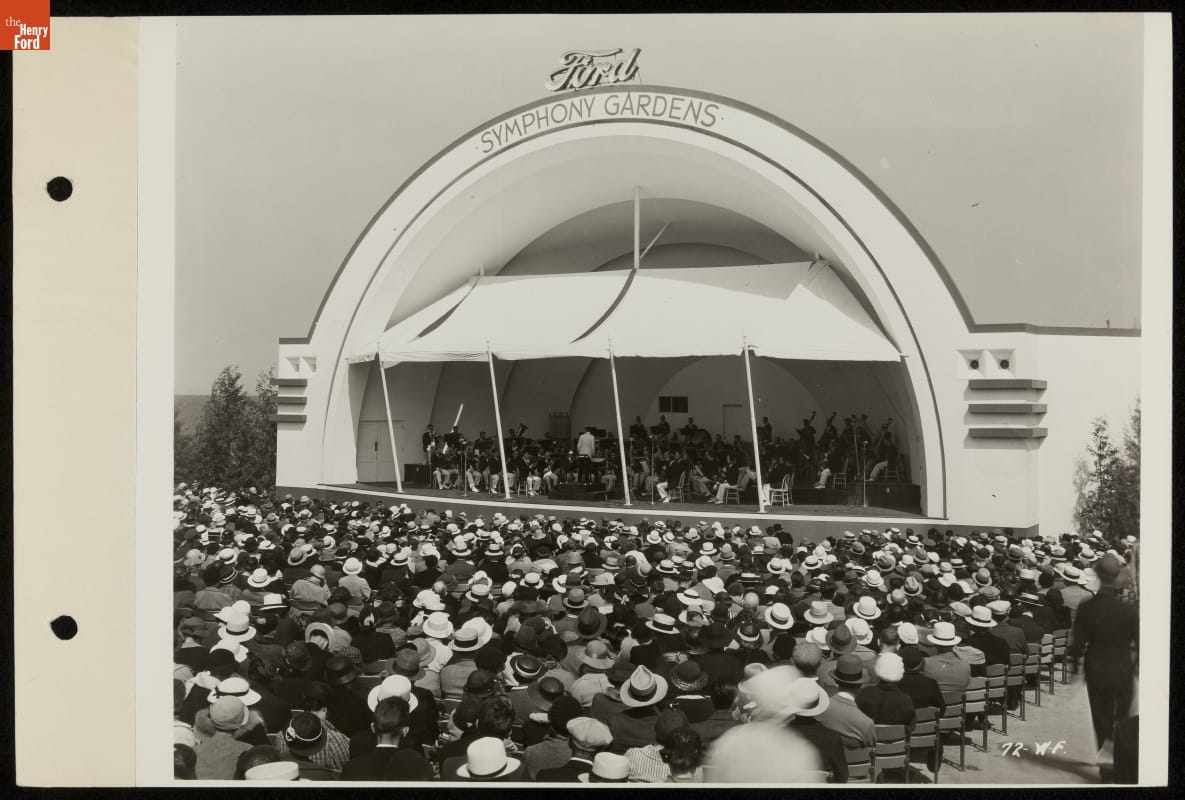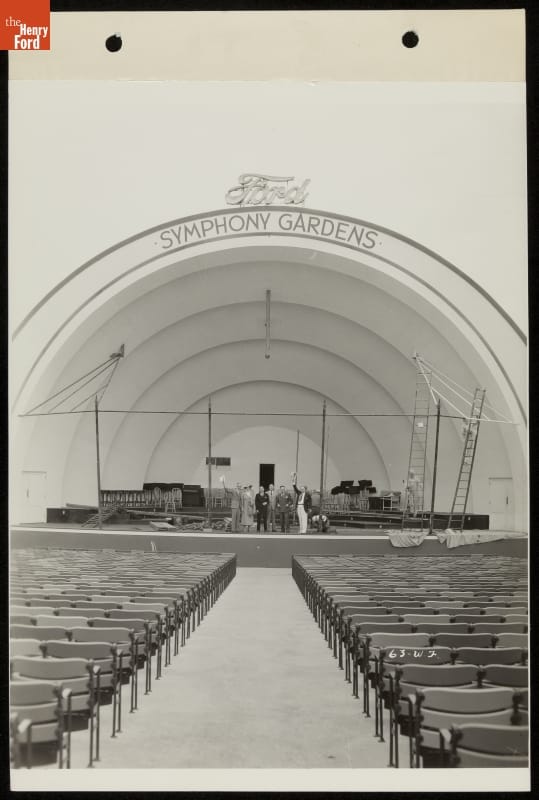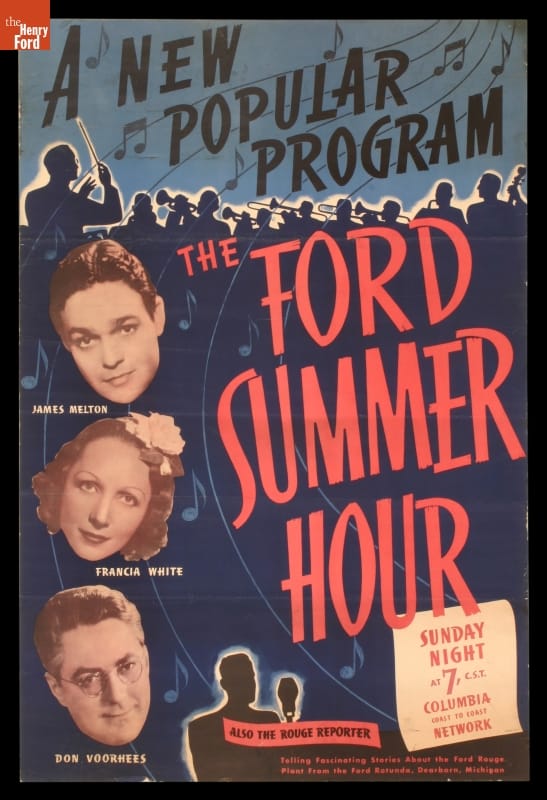Posts Tagged edsel ford
Henry Ford and the Detroit Symphony Orchestra

Concert in the Ford Symphony Gardens, Century of Progress International Exposition, Chicago, Illinois, 1934. THF212561
For the past 24 years the Detroit Symphony Orchestra and The Henry Ford have teamed up for Salute to America, our annual concert and fireworks celebration in Greenfield Village. But the affiliation between the DSO and our organization goes back much farther than that.

Preparing for a Performance in Ford Symphony Gardens, Century of Progress International Exposition, Chicago, Illinois, 1934. THF212547
The connection dates back to the 1934 Chicago World's Fair, A Century of Progress International Exposition. Ford Motor Company’s exhibits were housed in the famous Rotunda building and also included the Magic Skyway and the Ford Symphony Gardens. The large amphitheater of the Symphony Gardens hosted several musical and stage acts, including the DSO, who Ford sponsored for 150 concerts over the course of the year. The symphonic notes proved so popular that Henry and Edsel Ford decided to launch a radio program featuring selections from symphonies and operas - the Ford Sunday Evening Hour. The weekly program played to over 10,000,000 listeners each broadcast over the CBS network (the same network that now presents The Henry Ford's Innovation Nation). Musical pieces were played by DSO musicians under the name Ford Symphony Orchestra, a 75-piece ensemble, and were conducted by Victor Kolar, the DSO’s associate director, for the first few years of the show. Pieces ranged from symphony classics including works by Handel, Strauss, Liszt, Wagner, Handel, Puccini, Bizet, and Tchaikovsky (including, of course, the 1812 Overture), to some of Henry Ford’s favorite traditional and folk songs like Turkey in the Straw and Annie Laurie, and even included popular tunes such as Night and Day by Cole Porter.
Each broadcast featured guest stars, soloists, and singers such as Jascha Heifetz, Grisha Goluboff, Gladys Swarthout, Grete Stükgold, and José Iturbi. The broadcast performances were open to the public for free, first at Orchestra Hall from 1934-1936, and then at the Masonic Temple 1936-1942. The show ran from 1934-1942, September-May with 1,300,000 live attendees and countless radio listeners tuning in.

Advertising Poster, The Ford Summer Hour, 1939. THF111542
Salute to America is our summer music tradition, and listeners in 1939 must have wanted some summer-themed music as well because Henry and Edsel started the Ford Summer Hour that year. Like the winter program, it was broadcast each Sunday evening on CBS, from May to September and featured a smaller 32-piece orchestra, again mostly made up of DSO musicians. Guest stars and conductors appeared, such as Don Voorhees, James Melton, and Jessica Dragonette.
The show included music from Ford employee bands like the River Rouge Ramblers, Champion Pipe Band, and the Dixie Eight. This was a program of lighter music, popular songs, and tunes from musical comedies and operettas. Apparently not everyone appreciated the lighter fare; a letter from a concerned listener stated:
“...as the strains of the trivial program of Ford Summer Show float into my room, I am moved to contrast them with the fine programs of your winter series, and to wonder why the myth persists that in hot weather the human mentality is unequal to the strain of listening to good music. Pardon me while I switch my radio to station WQXR which has fine music the year round.”
Strong words from the listening public, though apparently not the majority as the summer program rivaled the winter program with about 9,000,000 listeners per broadcast. The Ford Summer Hour, broadcast from the Ford Rotunda, only ran three seasons, but played a wide range of music for listeners such as Heigh Ho from Snow White, Dodging a Divorcee, selections from Carmen, Oh Dear, What Can the Matter Be, and One Fine Day from Madame Butterfly.
Both programs ceased by 1942 with the opening of World War II. Henry Ford II tried to bring back the Ford Sunday Evening Hour in 1945, broadcasting the same type of music by DSO musicians, but times and tastes had changed and the program was discounted after the first season.
Kathy Makas is a Benson Ford Research Center Reference Archivist at The Henry Ford. To learn more about the Ford Sunday Evening Hour or Ford Summer Hour, visit the Benson Ford Research Center or email your questions to us here.
Greenfield Village, events, Salute to America, by Kathy Makas, Ford Motor Company, Edsel Ford, Ford family, radio, world's fairs, Michigan, Henry Ford, music, Detroit
Detroit Industry Frescoes: The Backstory
The Diego Rivera and Frida Kahlo in Detroit exhibit will be on display at the Detroit Institute of Arts from March 15, 2015 through July 12, 2015. As a community partner for the exhibit, The Henry Ford has been digitizing selections from our collection that document Diego Rivera’s creation of the Detroit Industry frescoes and Diego and Frida’s time in Detroit. Below are links to six sets within our digital collections that bring some additional context to the exhibition.
Detroit Industry Frescoes: The Backstory
Edsel Ford funded the Detroit Industry frescoes, and Diego Rivera was inspired by the Ford Rouge Factory. As a result, Ford Motor Company, Edsel, Diego, and Frida became intertwined during the artists’ time in Detroit. This set features behind-the-scenes photographs of Diego, Frida, and others involved in the project; photos of Diego’s original drawings for the murals; a photograph taken by Ford Motor Company at Diego’s request; and correspondence between the DIA and Ford Motor Company about supplying glass and sand for the work.

20th century, 1930s, Michigan, Detroit, Ford Rouge Factory Complex, Ford Motor Company, Ford family, Edsel Ford, Detroit Institute of Arts, by Ellice Engdahl, art
Who Cancelled Edsel Ford's Detroit Lions Season Pass?
Earlier this week we shared another set of items that were recently digitized for our online collections: football artifacts to supplement our latest traveling exhibit, Gridiron Glory: The Best of the Pro Football Hall of Fame. One of those items is Edsel Ford’s 1934 season pass to home games of the Detroit Lions, which is actually on display inside the exhibit. In the picture of the pass you'll see that "Cancelled" is written in one of the top corners. After we shared the photo on Twitter yesterday Dave Birkett sent us this Tweet:
Anyone have any idea why "cancelled" would be written on that pass? @thehenryford
— Dave Birkett (@davebirkett) October 1, 2014
The explanation wasn't included in the online narrative for the pass and actually had several of us scratching our own heads - why was the pass cancelled? Thanks to Brian Wilson, Digital Processing Archivist at The Henry Ford, we found the answer. Here's Brian's report as he took a trip to our archives. - Lish Dorset Social Media Manager, The Henry Ford. Continue Reading
20th century, 1930s, sports, research, Michigan, Ford family, football, Edsel Ford, Detroit, by Lish Dorset, by Brian Wilson
It should come as no surprise, given the founder of this institution, that our digital collections already contain hundreds of items related to Henry Ford’s son, Edsel. We’ve just expanded this selection by digitizing some of Edsel’s childhood artwork. My personal favorite is this bear, made of brown thread stitched into paper and likely created when Edsel was between 5 and 10 years old, but other pieces include family portraits, highly geometric works, and slightly later, more sophisticated works. View these and other items related to Edsel Ford in our online collections.
Ellice Engdahl is Digital Collections & Content Manager at The Henry Ford.
Detroit, Michigan, 19th century, 20th century, 1910s, 1890s, Ford family, Edsel Ford, drawings, digital collections, childhood, by Ellice Engdahl, art
Edsel Ford's 1941 Lincoln Continental
Visitors to Henry Ford Museum will see a new vehicle in Driving America. Edsel Ford’s 1941 Lincoln Continental convertible is now in the exhibit’s “Design” section, located just behind Lamy’s Diner. The original Lincoln Continental, built between 1939 and 1948, is regarded as one of the most beautiful automobiles ever to come out of Detroit. It’s an important design story that we’re delighted to share.
The Continental’s tale began in the fall of 1938 as Edsel Ford returned from a trip to Europe. While overseas, Ford was struck by the look of European sports cars with their long hoods, short trunks and rear-mounted spare tires. When Ford got home, he approached Lincoln designer E.T. “Bob” Gregorie and asked him to create a custom car with a “continental” look. Using the Lincoln Zephyr as his base, Gregorie produced an automobile with clean, pure lines free of superfluous chrome ornaments or then-standard running boards. Continue Reading
1930s, 20th century, 1940s, luxury cars, Ford Motor Company, Ford family, Edsel Ford, design, convertibles, cars, by Matt Anderson
The Dearborn Inn Expansion

By late 1935, Edsel Ford, in consultation with the L.G. Treadway Company of New York City, was hard at work on a plan to add additional accommodations. A promotional brochure published by Treadway sums up the need for expansion:
“The Inn eventually became so popular that additional guest rooms were necessary. As the architectural plan of the Inn would not, with good taste or economic soundness, allow an addition, it was decided, after a thorough survey of the problem, to build separate cottages, or houses, to accommodate travelers. To be in keeping with the traditional environment these should be, externally, exact replicas of houses famous in American history, and, inside, afford the same comfort as enjoyed by guests at the Inn. The scheme calls for several houses to be grouped harmoniously as a Colonial Village.”
The brochure goes on to state that the landscape was to be carefully arranged, “such as might have grown around the original houses.”










The Treadway Company managed the Inn and the “Colonial Village” for just three more years, until 1939, when their contract expired. The Inn and the reproduction homes have endured and prospered over the decades. Today, visitors to Dearborn may experience these houses in much the same manner as guests in the 1930s. Fortunately for us, the Marriott Corporation, who manages the Village and Inn, have maintained the high standards set in the 1930s.
20th century, 1930s, Michigan, hotels, furnishings, Ford family, Edsel Ford, Dearborn Inn, Dearborn, by Charles Sable
Edsel Ford, the Treadway Company and the Founding of the Dearborn Inn

In the first piece, I discussed the unique nature of the Dearborn Inn, intended as an airport hotel and as a “front door” for visitors to our campus, Ford Motor Company and the Dearborn community. What I did not address was who conceived of the Inn and oversaw the project to its fruition. That individual was Edsel Ford. While it is generally acknowledged that Edsel Ford was a pivotal figure in the management of the Ford enterprise, individual achievements are rarely accorded to him. In the case of the Dearborn Inn, it is generally considered to be the conception of Henry Ford. While researching the scrapbook, I ran across reminiscences in our archives of Ernest Gustav Liebold (1884-1956), who served as Henry Ford’s executive secretary and financial manager. Mr. Liebold oversaw nearly all of Henry Ford’s business outside of Ford Motor Company. Mr. Liebold categorically states that the idea for the Dearborn Inn came from Mr. Edsel Ford. He continues to briefly discuss the construction of the Inn, specifically the interaction of architect Albert Kahn’s office with the Ford organization. Finally, Mr. Liebold states the following:
“Mr. Edsel Ford brought in Treadway to operate the Dearborn Inn. He also had Treadway at his Inn up in Maine. (Edsel Ford owned a large summer home near Seal Harbor, Maine.) Edsel bought it shortly after Mr. (Henry) Ford bought the Wayside Inn (in Sudbury, Massachusetts). He had that as an inn of his own, and Treadway operated it. Treadway was brought here at the same time and given a contract, I think for five years.”
This statement led me to investigate the Treadway Inn and its history. According to The Motel in America (1996) Treadway Inns were America’s earliest motel chain. They were founded accidentally by Mr. L.G. Treadway. In 1912 he took over operations at the Williams Inn at Williamstown, Massachusetts. (This inn continues today.) It was an old coaching inn, dating back to the early 19th century. Under Treadway’s management, the establishment was attractive, comfortable, and provided good meals. Treadway’s innovation came in 1920 when he and the owners of inns in nearby towns, specifically the Ashfield House of Ashfield, Massachusetts, and the Dorset Inn of Dorset, Vermont, combined resources. Guests were recommended to the associated inns, and employee exchanges took place. The three inns found economies of scale by combining advertising and purchasing; the resulting increase in business and decrease in costs brought increased profits – the affiliation grew into a chain, with many other New England inns added over time.
 Each inn maintained its own character, but they all shared comfort, good food and efficiency. They did not attempt to duplicate the hotels of big cities, but rather extend to all travelers old-fashioned rural New England hospitality. Once established, the chain made its headquarters, ironically, in New York City and always included the trademark, “The Real New England Inns” with a distinctive logo of a colonial innkeeper pointing with a cane in the left hand, lantern held high in his right.
Each inn maintained its own character, but they all shared comfort, good food and efficiency. They did not attempt to duplicate the hotels of big cities, but rather extend to all travelers old-fashioned rural New England hospitality. Once established, the chain made its headquarters, ironically, in New York City and always included the trademark, “The Real New England Inns” with a distinctive logo of a colonial innkeeper pointing with a cane in the left hand, lantern held high in his right.
While traveling from Michigan to his summer home in Maine, Edsel Ford likely encountered the Treadway chain. After experiencing “The Real New England Inns” it must have been a foregone conclusion for Edsel Ford to invite Treadway to manage the Dearborn Inn. According to articles in Ford News, Ford Motor Company’s in-house magazine, announcing the Inn’s opening in the summer of 1931, a number of the Inn’s staff was recruited from Treadway Inns throughout New England.



The Treadway firm managed the Dearborn Inn until 1939, when the contract with Ford was not renewed. A subsidiary of Ford known as Seaboard properties operated the Inn until 1983, when the Marriott Corporation took over.


For more insights on the Dearborn Inn and lots of great images, take a look at Jennifer Czerwick Ganem’s Images of America: Dearborn Inn (Charleston, South Carolina: Arcadia Publishing, 2011).
Charles Sable is Curator of Decorative Arts at The Henry Ford.
20th century, 1930s, Michigan, hotels, Ford family, Edsel Ford, Dearborn Inn, Dearborn, by Charles Sable






